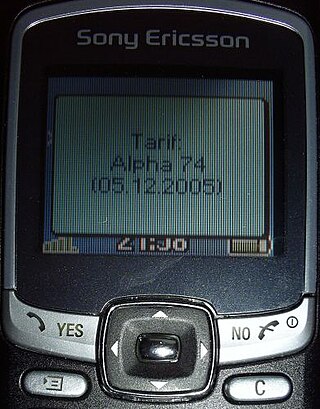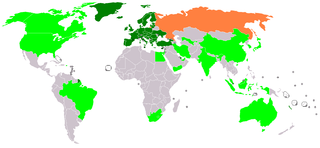
Enhanced Data rates for GSM Evolution (EDGE), also known as 2.75G, Enhanced GPRS (EGPRS), IMT Single Carrier (IMT-SC), and Enhanced Data rates for Global Evolution, is a digital mobile phone technology that allows improved data transmission rates as a backward-compatible extension of GSM. EDGE is considered a pre-3G radio technology and is part of ITU's 3G definition. EDGE was deployed on GSM networks beginning in 2003 – initially by Cingular in the United States.

The Global System for Mobile Communications (GSM) is a standard developed by the European Telecommunications Standards Institute (ETSI) to describe the protocols for second-generation (2G) digital cellular networks used by mobile devices such as mobile phones and tablets. GSM is also a trade mark owned by the GSM Association. GSM may also refer to the Full Rate voice codec.

General Packet Radio Service (GPRS), also called 2.5G, is a packet oriented mobile data standard on the 2G cellular communication network's global system for mobile communications (GSM). GPRS was established by European Telecommunications Standards Institute (ETSI) in response to the earlier CDPD and i-mode packet-switched cellular technologies. It is now maintained by the 3rd Generation Partnership Project (3GPP).
The Universal Mobile Telecommunications System (UMTS) is a third generation mobile cellular system for networks based on the GSM standard. Developed and maintained by the 3GPP, UMTS is a component of the International Telecommunication Union IMT-2000 standard set and compares with the CDMA2000 standard set for networks based on the competing cdmaOne technology. UMTS uses wideband code-division multiple access (W-CDMA) radio access technology to offer greater spectral efficiency and bandwidth to mobile network operators.
The 3rd Generation Partnership Project 2 (3GPP2) was a collaboration between telecommunications associations to make a globally applicable third generation (3G) mobile phone system specification within the scope of the ITU's IMT-2000 project. In practice, 3GPP2 was the standardization group for CDMA2000, the set of 3G standards based on the earlier cdmaOne 2G CDMA technology.
4G is the fourth generation of broadband cellular network technology, succeeding 3G and preceding 5G. A 4G system must provide capabilities defined by ITU in IMT Advanced. Potential and current applications include amended mobile web access, IP telephony, gaming services, high-definition mobile TV, video conferencing, and 3D television.

Unstructured Supplementary Service Data (USSD), sometimes referred to as "quick codes" or "feature codes", is a communications protocol used by GSM cellular telephones to communicate with the mobile network operator's computers. USSD can be used for WAP browsing, prepaid callback service, mobile-money services, location-based content services, menu-based information services, and as part of configuring the phone on the network. The service does not require a messaging app, and does not incur charges.
OMA SpecWorks, previously the Open Mobile Alliance (OMA), is a standards organization which develops open, international technical standards for the mobile phone industry. It is a nonprofit Non-governmental organization (NGO), not a formal government-sponsored standards organization as is the International Telecommunication Union (ITU): a forum for industry stakeholders to agree on common specifications for products and services.
Adaptive Multi-Rate Wideband (AMR-WB) is a patented wideband speech audio coding standard developed based on Adaptive Multi-Rate encoding, using a similar methodology to algebraic code-excited linear prediction (ACELP). AMR-WB provides improved speech quality due to a wider speech bandwidth of 50–7000 Hz compared to narrowband speech coders which in general are optimized for POTS wireline quality of 300–3400 Hz. AMR-WB was developed by Nokia and VoiceAge and it was first specified by 3GPP.
Customized Applications for Mobile networks Enhanced Logic (CAMEL) is a set of standards designed to work on either a GSM core network or the Universal Mobile Telecommunications System (UMTS) network. The framework provides tools for operators to define additional features for standard GSM services/UMTS services. The CAMEL architecture is based on the Intelligent Network (IN) standards, and uses the CAP protocol. The protocols are codified in a series of ETSI Technical Specifications.
3GP is a multimedia container format defined by the Third Generation Partnership Project (3GPP) for 3G UMTS multimedia services. It is used on 3G mobile phones but can also be played on some 2G and 4G phones.
Multimedia Broadcast Multicast Services (MBMS) is a point-to-multipoint interface specification for existing 3GPP cellular networks, which is designed to provide efficient delivery of broadcast and multicast services, both within a cell as well as within the core network. For broadcast transmission across multiple cells, it defines transmission via single-frequency network configurations. The specification is referred to as Evolved Multimedia Broadcast Multicast Services (eMBMS) when transmissions are delivered through an LTE network. eMBMS is also known as LTE Broadcast.

Cell Broadcast (CB) is a method of sending messages to multiple mobile telephone users in a defined area at the same time. It is defined by the ETSI's GSM committee and 3GPP and is part of the 2G, 3G, 4G LTE (telecommunication) and 5G standards. It is also known as Short Message Service-Cell Broadcast (SMS-CB) or CB SMS.

High Speed Packet Access (HSPA) is an amalgamation of two mobile protocols—High Speed Downlink Packet Access (HSDPA) and High Speed Uplink Packet Access (HSUPA)—that extends and improves the performance of existing 3G mobile telecommunication networks using the WCDMA protocols. A further-improved 3GPP standard called Evolved High Speed Packet Access was released late in 2008, with subsequent worldwide adoption beginning in 2010. The newer standard allows bit rates to reach as high as 337 Mbit/s in the downlink and 34 Mbit/s in the uplink; however, these speeds are rarely achieved in practice.

The European Telecommunications Standards Institute (ETSI) is an independent, not-for-profit, standardization organization in the field of information and communications. ETSI supports the development and testing of global technical standards for ICT-enabled systems, applications and services.

LTE Advanced is a mobile communication standard and a major enhancement of the Long Term Evolution (LTE) standard. It was formally submitted as a candidate 4G to ITU-T in late 2009 as meeting the requirements of the IMT-Advanced standard, and was standardized by the 3rd Generation Partnership Project (3GPP) in March 2011 as 3GPP Release 10.

The Next Generation Mobile Networks (NGMN) Alliance is a mobile telecommunications association of mobile operators, vendors, manufacturers and research institutes. It was founded by major mobile operators in 2006 as an open forum to evaluate candidate technologies to develop a common view of solutions for the next evolution of wireless networks. Its objective is to ensure the successful commercial launch of future mobile broadband networks through a roadmap for technology and friendly user trials. Its office is in Frankfurt, Germany.

ip.access Limited is a multinational corporation that designs, manufactures, and markets small cells technologies and infrastructure equipment for GSM, GPRS, EDGE, 3G, 4G and 5G. The company was acquired by Mavenir in September 2020.
International Mobile Telecommunications-2020 are the requirements issued by the ITU Radiocommunication Sector (ITU-R) of the International Telecommunication Union (ITU) in 2015 for 5G networks, devices and services.










